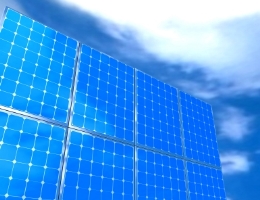Panel Types
Mono-crystalline Silicon Cells:
Made using cells saw-cut from a single cylindrical crystal of silicon, this is the most efficient of the photovoltaic (PV) technologies. Mono-crystalline cells have high efficiencies, typically around 15%, although the manufacturing process required to produce mono-crystalline silicon is complicated, resulting in slightly higher costs than other technologies.
Poly-crystalline Silicon Cells (multi-crystalline):
Made from cells cut from an ingot of melted and recrystallised silicon. In the manufacturing process, molten silicon is cast into ingots of polycrystalline silicon; these ingots are then saw-cut into very thin wafers and assembled into complete cells. Poly-crystalline cells are cheaper to produce than mono-crystalline ones.
Thick-film Silicon:
Another multi-crystalline technology where the silicon is deposited in a continuous process onto a base material giving a fine grained, sparkling appearance. Like all crystalline PV, this is encapsulated in a transparent insulating polymer with a tempered glass cover and usually bound into a strong aluminium frame.
Amorphous Silicon (thin film):
Amorphous silicon cells are composed of silicon atoms in a thin homogenous layer rather than a crystal structure. Amorphous silicon absorbs light more effectively than crystalline silicon, so the cells can be thinner. For this reason, amorphous silicon is also known as a "thin film" PV technology. Typical efficiencies of around 6%, but they are easier and therefore cheaper to produce.
Photovoltaic electricity generation can be calculated from the following formula from the SBEM Technical Manual available from BRE
QPV = I • KE • (1-KS) • A
Where:
| QPV: | the annual electricity produced by the photovoltaic modules (kWh) |
| I: | the global solar radiation at the module surface (kWh/m2) |
| KE: | the module efficiency of conversion (%)- see table 1 |
| KS: | the system losses (%)- see table 2 |
| A: | area of the photovoltaic module excluding the supporting construction (m2) |
| Table 1: Conversion Efficiency | Table 2: System Losses | |||
| Mono-crystalline | 15% | Inverter losses | 7.5% | |
| Poly-crystalline | 12% | Module shading | 2.5% | |
| Amorphous | 6% | Module temperature | 3.5% | |
| Other thin films | 8% | Shading | 2% | |
| Mismatch and DC losses | 3.5% | |||
| MPP mismatch error | 1.5% | |||
| AC losses | 3% | |||
| Other | 1.5% | |||
| Total Losses | 25% |
Data from the SBEM Technical Manual available from BRE
Other Examples
Also see the Carbon Trust article solar electricity photovoltaics ![]()


